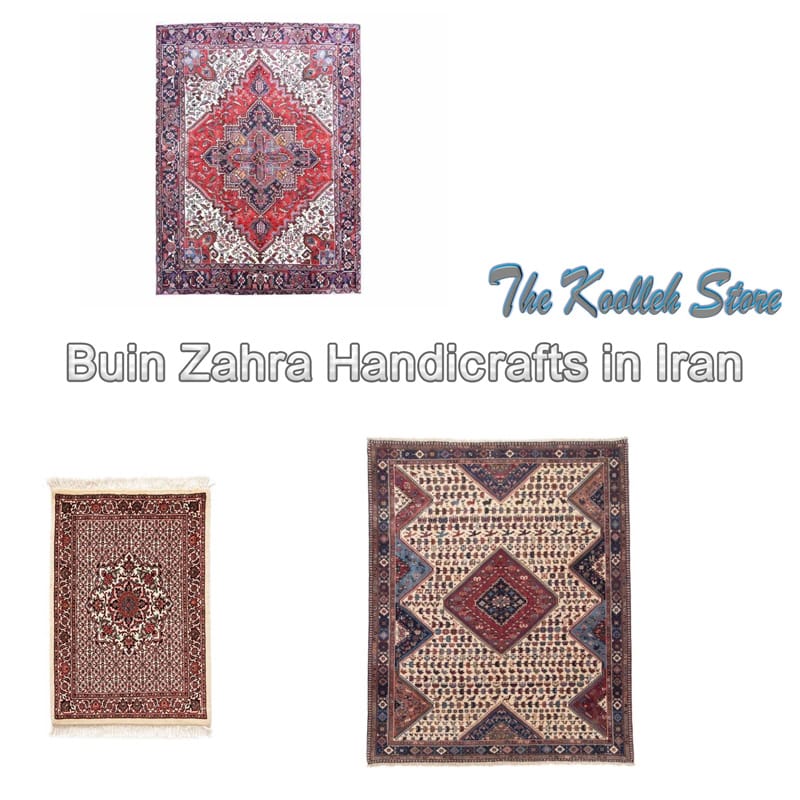Buin Zahra Handicrafts in Iran

The city of Buin Zahra is located south of the Qazvin Plain, 50 kilometers from Qazvin. Its headquarters is in the city of Bojnezhara and has six districts called Markazi, Spa, Avaj, Dashtabi, Ramand and Shal, and 14 villages and about 320 towns.
It covers an area of about 6,000 square kilometers and has a population of about 148,000 from the north to Qazvin and Alborz, from the south to the central provinces of Hamadan, from the east to the province of Tehran, and from the west to the city of Takestan.
The record of living in the city of Buenos Aires dates back to BC. Qazvin Plain has an ancient civilization that can be seen in the hundreds of ancient hills of this region, with a long civilization of more than 9 years.
Discovered in gold, bronze and pottery with plaid motifs and animal paintings, diversity and proportion in shape and coloring are among the valuable examples of prehistoric pottery in the area.
The earthquakes that have taken place in this area have had a great impact on the history and habitation of its people.
Sightseeing centers of the city include the dual towers of Kharqan, Mohammadabad Caravanserai, Avaj Caravanserai, Hojib Caravanserai, Seksabad Historic Site, Zagheh Hill and Cemetery Hill.
The existence of historic inns and hills proves the importance of this area in trading and being in a busy area and the crossroads of various cities, as the historic Silk Road passes through this city.
Among the arts and crafts in the city of Buin Zahra, mainly carpet weaving and carpet weaving can be mentioned. Carpet and carpet weaving has long been prevalent in the area and has maintained its prosperity to this day. The proximity of this area to the central parts of Iran shows the effectiveness of the motifs and hand-made products.
kilim weaving
The plain has unique kilims called its largest village, the mud or flower. This role is very similar to the motifs of Bijar, Khamseh and Shahsun. Almost all the houses in Dashtashi area, especially Ardaq, have a kilim.
The kilim in this region is called “kilim” and the technique used in the texture is double, slit and curved. Most of the holdings in this area are horizontal and made of metal. Characteristics of these kilims include the use of vibrant, sharp and complementary colors. The motifs come from nature and the environment, human figures and designs of birds and plants.
In kilims we have less geometric motifs. Sparse weaving, multiple motifs, and twisting patterns and asymmetric arrangement are common in kilim weaving. Curved and fringed motifs are found in these kilims, and the well-known names of the kilim motifs can be dolls (rollbacks), caterpillars (almonds), almonds, stars, trout, Amin Aghan, and others.
carpet weaving
Carpet weaving is common in most of the villages of Boyain Zahra and is now well-flourished. In the past, the texture of rural and mental carpets was widespread, but in recent years carpet weavers have switched to carpets of Qom and Tabriz under the supervision of chloroform.
The woven carpets in this area are very varied in design and color, and in some motifs are similar to the designs of the carpets of this area. Most of the carpets are black and red, and the role of the pond and the variety of plant and bird motifs can be seen in the carpet text.
Weavers in the area believe that Friday is not an appropriate or appropriate day to start the day. In bridal décor, the hand-carved glitter was an integral part of the tradition, which is still the case.
Other handicrafts in the province
Striped jejunal tissue has been prevalent in most areas of the city in the past, which is unfortunately forgotten. Other handicrafts identified in the area include weaving, traditional weaving, traditional forging, woodworking, traditional jewelry, traditional embroidery, hooks, weaving, weaving, and others.
Bojin Zahra is generally considered to be one of the richest areas in the handicraft industry in Qazvin province, although several earthquakes have occurred in the area, especially the earthquake of 1341 and the recent earthquake in Avaj, causing serious damage and migration of many people to nearby cities. The artistic spirit in these areas has left indigenous arts in the limelight, and it is hoped that promotional programs can help to preserve the arts in the area.






Leave A Comment
You must be logged in to post a comment.